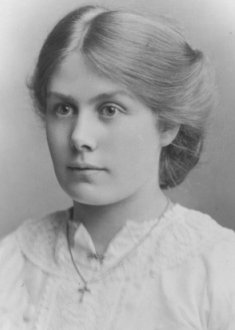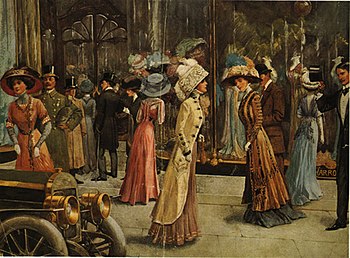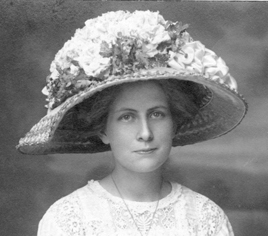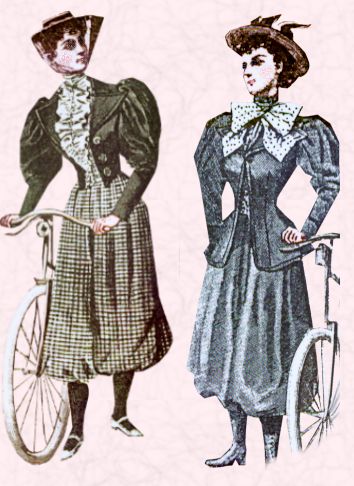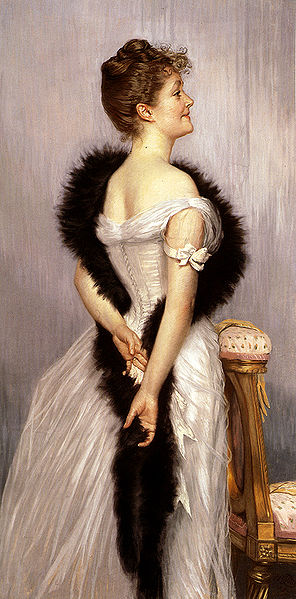During my research for this week's post, I've found it hard to stay focused. That's most likely because every garment I'm looking at reminds me of the amazing costumes in this show you might have heard of.
I've always been in love with the costumes on Downton Abbey (designed by Susannah Buxton and Rosalind Ebbutt), but as I've been researching the decadent, art nouveau-inspired styles of the 1910's, I have a new-found respect for the series.
Fashion in the 1910's can be split roughly into two parts; the luxurious, feminine, pre-war styles, and the simpler cuts and darker colors that came out of necessity during wartime.
Let's take a look.
Near the beginning of the decade, waistlines on some dresses rose from the low, pigeon-breasted styles to what could almost be called an empire waistline, just above the natural waist.
Though corseting was still as rigid as ever, bodices were looser and more tunic-like. In fact, entire evening gowns in high fashion were draped and decorated to reflect the popular Art Nouveau aesthetic and Europe's fascination with Eastern exploration.
Day wear was decidedly more conservative, with simple but tasteful walking suits or dresses for when a lady ventured away from home, and light, summery day dresses for when she stayed in.
During these first few years of the 1910's, Jeanne Paquin, the first female couturier, reached the peak of her career. She organized the first fashion shows, and according to Wikipedia, often sent her models to operas and races to show off her designs. Her style celebrated the best of the old and foreshadowed the new, setting trends that would appear later in the 1920's, and also creating evening gowns inspired by the 18th century.
In July, 1914, World War I broke out, and the time for elaborate, extravagant clothing was over. As more and more men disappeared into the trenches, more women went to work. Bear with me here, because a really good example of this change is Downton Abbey, season 2. Sybil Crawley goes from a decked out debutante to a nurse, Edith changes out her beaded evening gowns for a jacket and bicycle trousers to work on a farm, and Cora shows her true potential (and true colors) when she transforms from socialite-turned-mistress of Downton to the all-business, no-nonsense manager of the officer's hospital that Downton Abbey becomes. Even women who aren't actively working for the war effort, like Mary, sport darker colors and simpler, more utilitarian cuts and textiles.
Sybil's evening wear before the war is cutting edge (harem pants! Scandalous), with bright colors and a brocade-like fabric on the bodice.
Though much fancier than
her nurse's uniform, Sybil's evening wear after the war is much simpler than before. Black fabric with an unremarkable cut and pattern. The character has several dresses like this in her wardrobe.
Mary's pre-war day wear is characterized by wide-brimmed hats, feminine details, and luxury fabrics.
During and after the war, Mary's day outfits are much darker, with two-piece monochromatic suits (very popular during wartime) and hats with small brims.
As you can see above, wide-brimmed hats were very popular at the beginning of the decade. They were worn over hair that was pulled back into a simple bun, sometimes worn at the nape of the neck.
Bobbed hair became fashionable in Paris in 1909, and was beginning to be accepted in fashion forward circles around Europe during the war, but most respectable women kept their hair long. As the decade wore on, hats became smaller, with brims that framed the face. This type of hat was an early version of the cloche that we'll see as we go into the 1920's and 30's.
Next week, we have a really fun decade on our hands; the Roaring 20's. The beginning of the modern era and freedom in art, music, and politics. Not to mention the return of beading and other decoration in fashion (
and how). Until then, I'll leave you with
this fun clip of an actual fashion show from 1917. Enjoy!

















